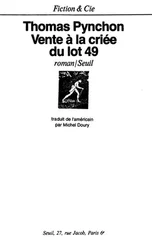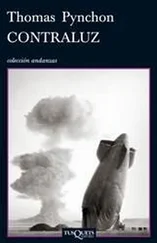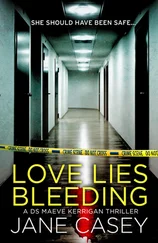It was in one of these cubicles that the police found Lester’s corpse propped up as if gazing into the pool, where earlier a swimmer had noticed him and after a couple more laps, getting the picture, freaked out. According to the papers, a knife-blade of some sort had been driven with great force into Lester’s skull, apparently not by hand because part of the tang still protruded from Lester’s forehead. The absence of a knife-handle suggested a spring-propelled ballistic blade, illegal in the U.S. since 1986, though said to be standard issue for Russian special forces. The Post , for whom the Cold War still emits a warm nostalgic glow, loves stories like this, so the screaming began, KGB assassination squads running loose through the city and so forth, and this sort of thing would go on for the better part of a week.
When she saw the headline, “GONE BALLISTIC!,” Maxine rang up Rocky Slagiatt. “Your ol’ Spetsnaz buddy Igor Dashkov. He would’t happen to know anything about this.”
“Already asked him. He says that knife is a urban myth. He was in the Spetsnaz for about a century and never saw one.”
“Not quite my question, but—”
“Hey. Wouldn’t rule out a Russian hit. On the other hand…”
Right. Wouldn’t rule out somebody trying to set it up to look like a Russian hit, either.
The crime scene itself here, meanwhile, looks pretty picked over. There’s yellow tape around, and chalk marks, along with discarded plastic evidence pouches and cigarette butts and fast-food packaging. Ignoring a background haze of cop aftershave, tobacco smoke, stomach effluxes from neighborhood saloons, crime-lab solvents, fingerprint powder, luminol—
“Wait, you can smell luminol? Isn’t it supposed to be odorless?”
“Nah. Notes of pencil shavings, hibiscus, number-two diesel, mayonnaise—”
“Excuse me, that’s wine-maven talk.”
“Oops…”
Filtering, howsoever, these other odors out, Conkling enters orbit around the central fact of the stiff that was here, that in the one professional sense is still here, problematical now because of what forensic Noses like to call the deathmask, the way the indoles of bodily decay assume precedence over all other notes that might be present. There are differential techniques for getting around this, of course, one attends oddly furtive all-weekend seminars in New Jersey to learn them, sometimes these have practical value, sometimes it’s all just New Age gobbledygook from the eighties that the gurus presiding have found it difficult to move comfortably on from, thus allowing the ever-hopeful attendee to flush another $139.95 plus tax into the soil stack of his fiscal affairs. Half of it IRS-allowable, but usually, vaguely, a disappointment.
“Just do a grab, here—” Conkling going in his duffel and pulling out some heavy-duty plastic bags and a little pocket-size unit and a plastic fitting.
“What’s that?”
“Air-sampling pump—cute, huh? Runs off a rechargeable battery. Just going to take a couple liters here.”
Waiting till they step out of the guest or freight elevator onto the street, the clamoring, soiled, innocent street, “So… what did you smell up there?”
“Nothing too unusual, except… before NYPD got there, before the gunsmoke, a scent, maybe a cologne, I can’t ID right offhand, commercial, maybe from a few years back…”
“Somebody who was there.”
Emerging from a moment of thought, “Actually I think it’s time to go check the library.”
Meaning, it turns out, Conkling’s own extensive collection of vintage perfumes, which Conkling keeps at his crib in Chelsea, where the first thing Maxine notices is a glossy black instrument sitting in a battery charger among a number of dramatically oversize ferns which may have mutated because of the apparatus in their midst, humming in more than one key, red and green LEDs glowing and blinking here and there, with a Clint Eastwood–size pistol grip and a long discharge cone. A creature hidden in jungle foliage, staring at her.
“This is the Naser,” Conkling introduces them, “or olfactory laser.” Going on to explain that odors can be regarded as if they had periodic waveforms, like sound or light. The everyday human nose receives all smells in a jumble, like the eye receives the frequencies of incoherent light. “The Naser here can separate these into component ‘notes,’ isolate and put each in phase, causing it to ‘cohere,’ then amplify as needed.”
Sounds a little West Coast, though the object looks intimidating enough. “This is a weapon? it… it’s dangerous?”
“In the same way,” Conkling supposes, “that sniffing pure rose attar will turn your brain into red Jell-O. Don’t want to be messing with no Naser, necessarily.”
“Can you, like, just set it on ‘Stun’?”
“If I have to use it at all, it means I’ve made a mistake.” He goes over to a glass-fronted cabinet full of flasks and atomizers, custom and commercial. “This scent—it’s not one I could place immediately, not fresh soap so much as disinfectant. Not tobacco so much as stale cigarette butts. Some civet maybe, but Kouros it ain’t. Nonhuman urine as well.” Maxine recognizes this as magician’s patter. Conkling opens one of the cabinet doors and reaches out a four-ounce spray bottle, holds it about a foot from his nose, and without hitting the plunger appears to inhale slightly. “Whooboy. Yep, this is it. Check it out.”
“‘9:30’,” Maxine reads from the label, “‘Men’s Cologne.’ Wait, is this the 9:30 Club down in D.C.?”
“The same, although it’s no longer at the old F Street address, where it was located when this stuff was sold, back in the late eighties sometime.”
“That’s a while. This must be the last bottle in town.”
“You never know. Even an example like this that comes and goes, there can still be thousands of gallons out there in the original packaging, just waiting to be found by scent collectors, nostalgists, in this case unreconstructed punk rockers, and don’t rule out the insane. The original manufacturer got bought by somebody else, and 9:30 if I remember right was then relicensed. So we’re pretty much left with the secondary market, discount houses, ads in the trades, eBay.”
“How important is this?”
“It’s the chronology that’s bothering me here—too close to the gunsmoke not to be part of the event. If they’ve brought in Jabbering Jay Moskowitz on this, then he already knows of the connection, meaning so does everybody in the NYPD including meter readers. Jay is a top forensic Nose but isn’t always clear on how professionally to share information.”
“So… a guy wearing this…”
“Don’t rule out a woman who might have been in close contact with a man wearing it. Someday there’ll be search engines you can just input a little spritz of anything and voilà, nowhere to run to, nowhere to hide, the whole story will be there on the screen before you can scratch your head in amazement. Meantime there’s the Nose community. Anecdotal material. I’ll ask around.”
There arrives the usual moment of awkward silence. Conkling still has an erection but, as if it’s hardware he’s lost the manual to, is hesitant about deploying it. Maxine herself is of two minds. Something seems to be going on that nobody’s telling her. The moment, howsoever, passes, and before she knows it, she’s back at the office. Ah well, as Scarlett O’Hara observes at the end of the movie…
• • •
SHE DREAMS SHE’S ALONE on the top floor of The Deseret, by the pool. Under the unnaturally smooth surface, visible through the optically perfect water, almost as an afterthought to the anxious vacancy of the space, a male Caucasian corpse in a suit and tie stretches face-up full length on the bottom as if taking a break from afterlife affairs, rolling, in some eerie semisleep, from one side to another. It is Lester Traipse, and it isn’t. When she leans over the edge to get a closer look, his eyes open and he recognizes her. He doesn’t have to rise up through the surface to speak, she can hear him from underwater. “Azrael,” is what he’s saying, and then again, with some urgency.
Читать дальше












